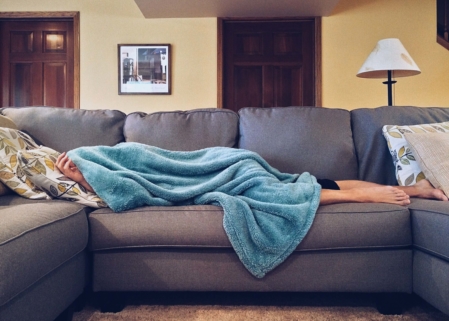Is Your House Making You Sick?
There’s my-house-has-ugly-wallpaper sick, and there’s my-house-might-be-making-me-sick. If your home has to fall into one of those categories, we’d hope it’s the former. But there are a lot of environmental factors that could exist in your home (especially if it’s older) which could lead to illness.
We’re no doctors, but we know houses. If you’ve dealt with persistent illness or health issues that just don’t seem to go away, it’s worth investigating if your house is the culprit.
Asbestos

Once considered a miracle material, we now know that asbestos can cause cancer. Asbestos in homes was used for tiles and insulation among other things before being banned in 1977. If your home was built before this time, there’s a chance it could have asbestos.
As much as we humans love to dive into DIY renovations, it’s important to find out if you have asbestos before ripping things apart. Otherwise, you might be at risk for exposure. Hire a contractor or environmental consulting firm to check your home.
Silica Dust
Silica is found in anything from drywall to ceramic and brick. Especially when renovating (or if something made of silica is broken apart on accident), silica dust in homes is harmful when inhaled. It’s nearly microscopic, but can cause lung lesions and make people more at-risk for developing diseases.
When Americans are exposed to asbestos today, it is usually through renovation or demolition work on an old building that still contains legacy asbestos products.
Black Mold
No one wants mold in their homes — any type can cause health problems — but black mold is notorious for health issues. Coughing, sneezing, headaches, and fatigue are all symptoms that your home might have black mold, otherwise known as Stachybotrys chartarum.
You can tell if you have black mold in your house by these signs:
- Mold in damp or humid areas (or areas exposed to water damage)
- Mold that’s black in color
- A strong, musty odor
Lead Poisoning

With these pipes wreaking havoc on cities like Flint, MI, we know more than we once did about the dangers of lead. According to the EPA, “Lead pipes are more likely to be found in older cities and homes built before 1986.”
Lead paint was also commonly used up until 1978. Consuming (such as kids eating loose paint chips) or inhaling can lead to poisoning. There are myriad symptoms that can affect people cognitively or physically. If you suspect lead in your home, contact a licensed lead risk assessor.
Allergens
Allergies can develop seemingly out of the blue, but we can also become aware of them when circumstances change. For example, you might grow up in the Midwest, move to the plains of Wyoming, and realize you’re allergic to sagebrush.
Homes can carry a ton of potential allergens — dust and pet hair are common, even if you don’t have pets, the previous owners might have. Getting tested could be worth it if you consistently have symptoms when at home. It’s also good to check if these symptoms change when you spend time outside of your house or area.
Your home should be a place of rest and comfort, not a cause for sickness. It might cost a fortune to change any structural house issues, which is where RealtyHive comes in. You can sell your home as-is and find a new house, all in one place. Check through our listings and start feeling better.
- What House to Buy, Based On Your Zodiac Sign - August 28, 2020
- 6 Misunderstood Things About Buying & Selling Houses - August 23, 2020
- 5 Things to Know About 401K Real Estate Investing - August 17, 2020




Trackbacks & Pingbacks
[…] Lead pipes, asbestos, a crumbling foundation — these are the not-so-great parts of owning an old house. There’s a solid chance you’ll need to update the home with everything from light fixtures and wall sockets to adding air conditioning. […]
Leave a Reply
Want to join the discussion?Feel free to contribute!